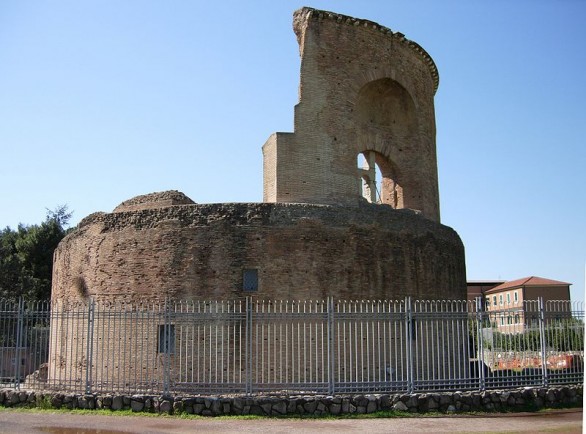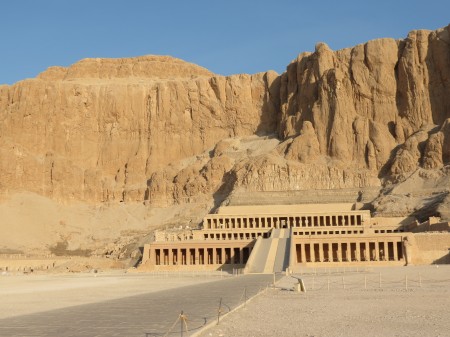https://ift.tt/1qzYOjt
There are an innumerable amount of ancient structures still standing to this day, such as the Great Pyramids of Giza or Stonehenge. However, many of these are dedicated to gods or men, with very few built for the glory of the female gender. Here are ten example of ancient buildings constructed for women.
10. The Mausoleum of Helena
Built during the 360s or 370s, this mausoleum was originally thought to have been built for Emperor Constantius’ sister Constantia, but further research has indicated it was actually meant for his other sister, Helena Augusta. She was the wife of an emperor, although he divorced her to take a more “regal” wife. She was also the mother of Constantine the Great, the first Emperor to convert to Christianity, and was sainted by the Catholic Church as a result. She’s the saint of difficult marriages, as well as divorces. In the ninth century, most of Helena’s remains were transferred to Reims, France because they were considered relics and the sarcophagus in which she was buried was later used in the funeral of Pope Anastasius IV. This was an apparently common practice of the rich families back then. The building itself has survived mostly intact, although the mosaics in the dome were destroyed during a 17th century restoration project. It was also later converted into a church, on the ruins of which now stands Saints Marcellinus and Peter at Two Laurels.
9. The Basilica of Saint Mary Major
Parts of this church date back to the pontificate of Pope Sixtus III, who ruled during the 5th century, and it is dedicated to Christ’s mother Mary. It is also the oldest church constructed in her honor, as the construction began only a few short years after she was officially declared to be the Mother of God. There is an old legend told about the church, first mentioned by Friar Bartolomé de Trento in the 13th century: a wealthy and reverent Roman couple wanted to donate money to the Church because they couldn’t have children. The Virgin Mary appeared to them in a dream and told them to build a church on the one place where snow fell that night. Upon waking up, the husband and Pope Liberio, who had the same dream, ventured out to the countryside and started the construction of the church on the spot they found. This is why it is sometimes referred to as “Our Lady of the Snows”. It has undergone numerous renovations and additions but it remains one of the oldest Christian churches in Europe. Though it is technically in Rome, thanks to the 1927 Lateran Treaty, the church enjoys the same status as an embassy for Vatican City.
8. The Tomb of Shangguan Wan’er
Shangguan Wan’er was the granddaughter of a prominent official during the reign of Emperor Gaozong in the 7th century. When Empress Wu Zetian rose to power, Shangguan Wan’er’s grandfather and father plotted to depose her because of their opposition, they were executed with Shangguan Wan’er sent into slavery as punishment. Due to her intellect and talent for poetry and statecraft, Shangguan Wan’er was eventually freed, promoted to the role of Wu Zetian’s personal secretary. She was given the job after being brought to the Empress and told to write an essay from scratch in front of Wu Zetian. A tomb was built in her honor, which, unfortunately, was partially destroyed after her death. The perpetrators were most likely officials acting on the wishes of Emperor Li Longji, who had Shangguan Wan’er executed when he took power, after a lengthy power struggle.
7. Huaca El Brujo
The only entry on this list dedicated to more than one woman, this tomb found in Trujillo, Peru dates back to the Moche people, a matriarchal society in ancient South America. The pre-Hispanic building dates back to at least the 9th century and was found with a number of artifacts, as well as the remains of five children and two adults, who were sacrificed upon the deaths of the priestesses. Climate change due to a massive El Niño, or social unrest contributed to the decline of the Moche people. Another tomb, housing the 1,700-year-old mummy of the Lady of Cao, one of the first female rulers of Peru, was found in a nearby area and is believed to be the earliest example of a Moche mummy. The remains of a second woman were found nearby, possibly there as a human sacrifice.
6. Rachel’s Tomb
Known to Jews as Rachel’s Tomb and to Muslims as the Bilal bin Rabah mosque, this ancient religious site was originally dedicated to Rachel, the Jewish matriarch who gave birth to Joseph, the bearer of the Amazing Technicolor Dreamcoat. Considered one of the top three holiest sites in Judaism, it’s located on the outskirts of Bethlehem, within a Muslim cemetery. Women who are trying to get pregnant are one of the main groups who make the yearly pilgrimage to the site. A grave marker was said to have been erected on the site of her burial in the 16th century B.C., with ancient authors describing it as 12 stones, representing the 12 tribes of Israel. Some sources say there were only 11 since Rachel died giving birth to Benjamin. A small domed building was eventually built over the site, and it was expanded in the 19th and 20th centuries.
5. The Tomb of Shert Nebti
Shert Nebti, otherwise spelled Sheretnebty, was a 5th dynasty Egyptian princess, whose life dates back nearly 4,500 years. Very little is known about her life and no information about either of her parents has ever been found. However, markings indicate her father’s name was King Men Salbo and numerous hieroglyphs express her importance, as well as the officials buried around her tomb. It was found in the burial ground near the famed step pyramid of Saqqara, leading archaeologists to believe a number of tombs still remain hidden in the area, waiting to be discovered, their reasoning that she is buried far away from most of the rulers of that era.
4. The Tomb of Lady K’abel
Lady K’abel was a Mayan queen during the 7th century and is considered perhaps the greatest queen of the Mayan civilization. Her identity had been known for years, due to her appearance on a prominent stone slab, Stela 34 of El Perú. However, her gravesite remained elusive, hidden for nearly 1,400 years until its discovery in 2012. Her name translates as “Lady Waterlily-Hand” or “Lady Snake Lord” and the discovery of her tomb, with all its regal glory, has once again reinvigorated the discussion of women and their role in Mayan society. She did rule with her husband but was considered to have higher authority than he. Another distinguishing feature about the tomb is that it is the one of the only “classical” archaeology finds in the Americas, a site which is also backed up with historical writings.
3. The Mausoleum of Cecilia Metella
Cecilia Metella is believed to have been the daughter of an extremely wealthy family during the 1st century B.C. and her mausoleum is thought to have been built in 50 B.C. Relatively little information about the structure is known, until 850 A.D., when it came into the possession of the Catholic Church. That is perhaps the reason for its relatively good condition, as is the fact that it was incorporated into a castle in the early part of the 14th century. The reason for the opulence of her mausoleum was most likely due to the fact that her husband, as well as her son, were famous generals of Rome, although their power had begun to diminish under Julius Caesar. Her son was actually denied the spolia opima, the traditional Roman spoils of war for victorious generals.
2. Mortuary Temple of Queen Hatshepsut
This mortuary temple is considered one of the most beautiful examples of its kind and it is dedicated to Queen Hatshepsut. She was a part of the 18th dynasty in Egypt and lived during the 15th century B.C., ruling for nearly 30 years and establishing herself as perhaps the greatest female pharaoh in Egyptian history. It is remarkably well-preserved, although many of the pictographs were destroyed by Hatshepsut’s nephew Thutmose III. Some scholars believe it could have actually been his son Amenhotep II, who may have done it for political reasons. For a number of years, it was used as a monastery and it was also the site of the Luxor Massacre, when 62 people, mainly tourists, were killed by Islamic extremists.
1. Bilikisu Sungbo
Believed by many to be the final resting place of the fabled Queen of Sheba, Bilikisu Sungbo is a burial site located deep in the Nigerian rainforest. (Though the monument wasn’t built until about 1,000 years ago, nearly 2,000 years after the Queen of Sheba is thought to have lived.) In the Jewish faith, she was an extremely powerful queen and she visited King Solomon, drawn by the tales of his wisdom. Biblical tradition also indicates she was black; a fact which seems to lend credence to the belief her grave is located at Bilikisu Sungbo. Whether that is true or not, the power wielded by the woman for whom the monument is built was immense, for it is larger in size than even the largest Egyptian pyramid. However, environmental erosion, as well as encroaching farmers, threaten the continued existence of the site.
TRENDS
TRENDS,AMAZING
via Toptenz.net http://www.toptenz.net
May 13, 2018 at 06:16PM
.png)











No comments:
Post a Comment